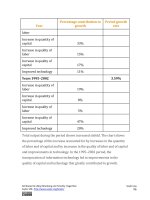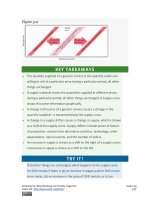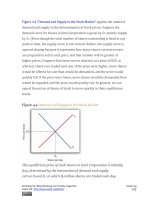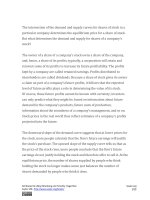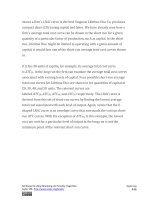Authors libby rittenberg 896
Bạn đang xem bản rút gọn của tài liệu. Xem và tải ngay bản đầy đủ của tài liệu tại đây (473.83 KB, 1 trang )
has a slope of −1. Roadside will produce more trucks (and fewer boats).
Seaside moves along its production possibilities curve to point B′, at
which the slope equals −1. Seaside will produce more boats (and fewer
trucks). Trade leads each country in the direction of producing more of
the good in which it has a comparative advantage.
Similarly, Seaside will specialize more in boat production. As shown in
Panel (b) of Figure 17.5 "International Trade Induces Greater
Specialization", producers will shift resources out of truck production and
into boat production until they reach the point on their production
possibilities curve at which the terms of trade equal the opportunity cost
of producing boats. This occurs at point B′; Seaside produces 3,000 trucks
and 6,000 boats per year.
We see that trade between the two countries causes each country to
specialize in the good in which it has a comparative advantage. Roadway
produces more trucks, and Seaside produces more boats. The
specialization is not, however, complete. The law of increasing opportunity
cost means that, as an economy moves along its production possibilities
curve, the cost of additional units rises. An economy with a comparative
advantage in a particular good will expand its production of that good only
up to the point where its opportunity cost equals the terms of trade.
As a result of trade, Roadway now produces more trucks and fewer boats.
Seaside produces more boats and fewer trucks. Through exchange,
however, both countries are likely to end up consuming more
of both goods.
Figure 17.6 "The Mutual Benefits of Trade" shows one such possibility.
Suppose Roadway ships 2,500 trucks per year to Seaside in exchange for
Attributed to Libby Rittenberg and Timothy Tregarthen
Saylor URL: />
Saylor.org
896
